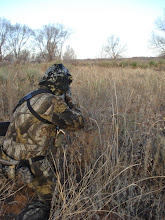I've been wearing a pair of Redhead Bayou zip-up snake boots for the last couple of years. I caught them on sale and it seems like I had a coupon of some kind so I didn't have to pay the retail price shown on their website, but I think they would be worth the asking price.
I have found them to be very comfortable even for long periods of time. They are also the first pair of zip-ups I've had. I love them. They go on and come off quick, which is important to me when I'm hunting or working outside. No more lacing up boots for me, thank you very much. That task gets worse and worse as the boots get taller.
If I'm going to be working or hunting in really heavy brush or in steep terrain where I might come across a rattlesnake up high enough for it to bit over my boots I wear snake chaps as well. I don't have a link for the one's I use, but you can go to Cabela's or Bass Pro and find a set. They cover me up to my crotch on the inside of my legs and nearly to my belt on the outside. They are heavy and stiff and hot, but I don't have to worry so much about an unscheduled trip to the emergency room. That is especially important when you are an hour and a half or more from the nearest emergency room.
Here is nice venomous snake my #2 son found at the farm on Dec. 28, so remember that snakes can and will come out any time it is warm enough for long enough. They don't truly hibernate, but rather do something called brumating, which is basically staying dormant when it is cold, but able to get up and hunt for food if it warms up for a day or two, then go back to a dormant state if the temperature drops again.

We had been hunting, then went back to the house to let him shoot the .22 a little bit. We would set up some cans and plastic bottles and he would shoot them and make them jump until they fell off the edge of the driveway where it drops into the field. We'd been at it maybe 20 minutes and we walked out to pick up the cans when he saw the snake sitting out in the short grass by the drive way, 10 feet from where the bullets were hitting. I thought the bullets hitting the ground would have scared him away, but I guess not. That was a good reminder that snakes don't just hang out in high grass.
Here is another little nasty that I found out in the field. I thought it was a stick when I first saw it. I guess the camo pattern works.

You can see the pit between the eye and the nostril.

You can see the "diamond" shape of the head in this picture.

Here is the business end of the little fellow.

Another tip is to keep a hoe or shovel within reach. Those are often your best tools to use against snakes. Use them to move objects before you pick them up. A fringe benefit of this policy is that you can also find out if there is a wasp nest in that pile of junk before you pick it up.
Keep your eyes open out there.


4 comments:
Nice rattler, and a good sized copperhead too :) We don't get rattlesnakes in my neck of the woods. In fact, in 15 years of animal control, I've only picked up two venomous snakes - both copperheads. One was in a pickle jar in a teenage boy's bedroom. Mom found it while cleaning. He was gonna keep it as a pet, not realizing what kind it was.
The diamond shaped head trick can deceive you, since most snakes will fake it when frightened. The pit you pointed out is a good indicator, though. Also, you'll notice the pupil is a slit, like a cat. Poisonous snakes have a slit pupil, while non-venomous ones are round - at least among Texas indigenous snakes.
Paladin,
Thanks for the pupil tip. Does that apply to coral snakes, too, or only pit vipers?
I understand about them faking. I've seen two black snakes that coiled up showed off a big white mouth, apparently trying to look like a water moccasin.
Does anyone know how to edit a comment? I had to delete it and make another.
I forget about coral snakes, since we don't get them around here. They aren't pit vipers like rattlers and copperheads and cottonmouths, so the pupil test sdoesn't apply to them.
The color pattern is so distinct for coral snakes, though, you and I would know them long before we got close enough to see the pupils anyway :)
Post a Comment